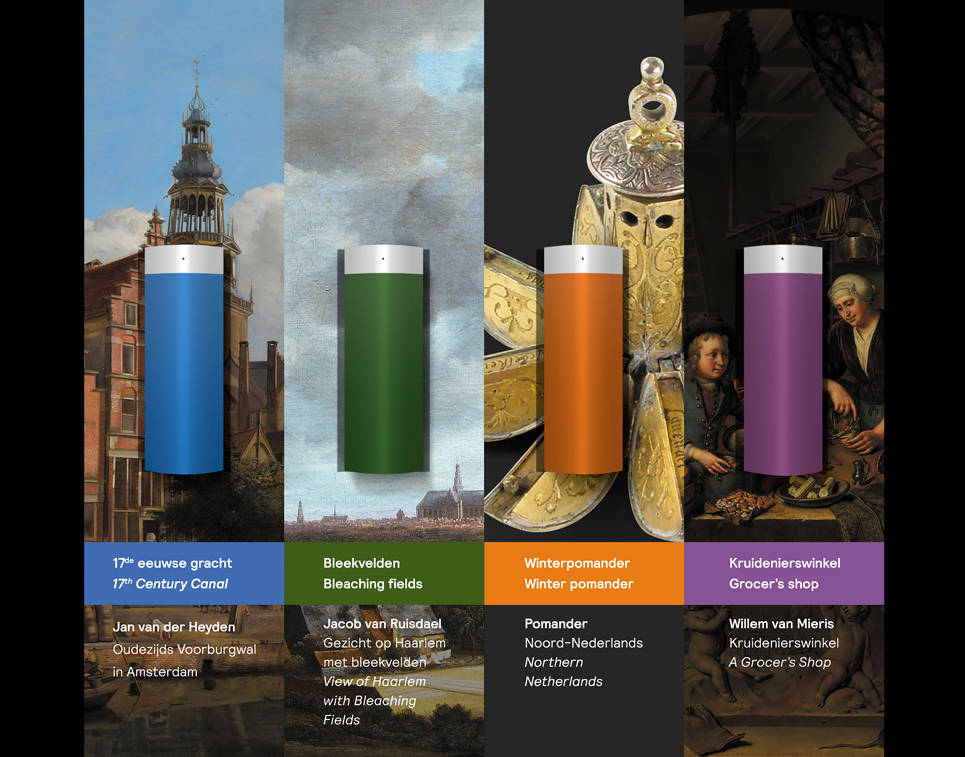Fragrance box
The fragrance box has been specially developed since the Mauritshuis’s new exhibition about scent cannot (yet) be visited due to the museum’s closure because of COVID-19. In the exhibition, several artworks are complemented by a scent pump so that visitors can smell as well as see the scents shown in the painting. The Mauritshuis is now also making this experience possible at home, be it in the Netherlands or further afield. Ideal for at home, but also for use in the classroom or together with your fellow residents in your care home, nursing ward and so on.
The fragrance box contains four scent pumps which allow you to smell the four scents at the same time that they appear in the tour. The 30-minute digital tour is accessed via a QR code (and URL), and can be viewed in a secure environment on YouTube.
The scent pumps are so-called dry air scenters, which last for a long time. The scents were produced by IFF (International Flavors and Fragrances) and are partly based on 17th-century formulas.
The information in the box appears in two languages (Dutch and English). The fragrance boxes are made from sustainable FSC cardboard. No alcohol has been used in the creation of the scents, making international delivery possible.
The scent of winter perfume
Wealthy ladies carried a pomander with them, a ball-shaped fashion accessory made from expensive materials such as silver. When inhaled, the various scents contained inside blended in the nose. These aromatic combinations offered protection against unhealthy odours, which was particularly important during plague outbreaks.
* You will smell different resins, musk, civet, clove, lavender, cypress, orris root and ambergris, as well as a dried gum - tragacanth, dissolved in aquavit and rose water.
The stench of a foul-smelling canal
The Dutch canals were extremely foul smelling in the 17th century. The sewer system was only installed in the early 20th century, which meant that before that time everything ended up in the water. The Oudezijds Voorburgwal in Amsterdam that appears in the painting by Jan van der Heyden would have smelled very different from today.
* You will smell the contents of toilets and sewers, offal, fish waste, rotting vegetables, horse manure, discarded hay and the stench of poisonous residues from polluting industries (such as the tanneries and textile production).
The aroma of a grocer's shop
People bought food, seasoning, coffee, tea, sugar and spices at the grocer’s shop. In the well-stocked establishment that appears in Willem van Mieris’s painting, containers of cloves, mace and nutmeg are arranged on the shelves – the names of the ingredients appear on the boxes.
* You will smell the aroma of this grocer’s shop: a blend of clove, nutmeg and mace.
The smell of the Dutch bleaching fields
The Dutch bleaching fields must also have smelled quite foul. The linen was bleached during a labour-intensive process in which it was treated with lye (boiled in a caustic mix of water and ash), washed in lactic acid, dyed with powdered cobalt, rinsed with fresh dune water and then laid out in the sun. Jacob van Ruisdael painted a number of these bleaching fields around Haarlem.
* You will smell a combination of all the ingredients listed above, mixed with the aroma of grass and textiles.
Joël Broekaert is a Dutch culinary journalist who writes about food and eating.
‘Smell is an extremely underrated part of our sensory perception and experience. Without your nose, you can’t taste a thing! Eating is uninteresting if you can’t smell as well. So being able to experience art in this way, not only with my eyes, but also with my nose, is an incredibly special experience.’
Fleur Hudig, Head of Corporate Citizenship NN Group:
‘As a partner and main sponsor of the Mauritshuis, we want to be there for them, particularly now when they are closed and can welcome no visitors. We are doing this by jointly investing in new possibilities to keep the collections accessible and by offering unique experiences. The Mauritshuis has previously organised livestreamed guided tours that could be enjoyed from home. With the addition of the fragrance box, the Mauritshuis is bringing an additional dimension to the at home experience.’
Fleeting – Scents in Colour is a voyage of discovery that will inspire viewers to experience art from a new perspective. In the exhibition at the Mauritshuis, there are a total of eight fragrances to smell.
Extended until 29 August 2021 (opening date dependent on the re-opening of museums in Netherlands).
www.mauritshuis.nl/en/fleeting

